Pat Mora's Blog, page 67
October 13, 2012
Celebrating Paper Tigers 10th Anniversary
Happy Anniversary to PaperTigers! Congratulations on their vision and the many accomplishments over the past ten years.
Artist John Parra designed this anniversary poster.
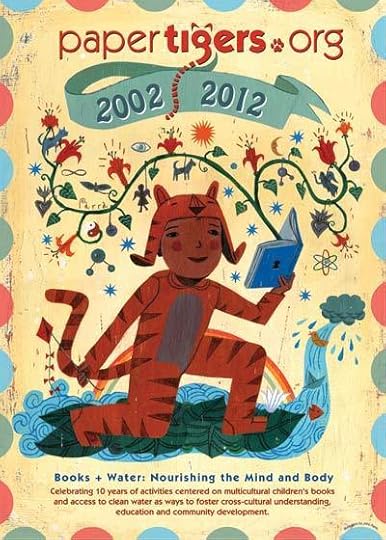
Read editor's Marjorie Coughlan’s thoughts about PaperTigers now and hopes for the future.
Former PaperTigers Managing Editor, Aline Pereira, has written an article about her long involvement with the website and othr resources.

Artist John Parra designed this anniversary poster.

Read editor's Marjorie Coughlan’s thoughts about PaperTigers now and hopes for the future.
Former PaperTigers Managing Editor, Aline Pereira, has written an article about her long involvement with the website and othr resources.
Published on October 13, 2012 07:49
October 5, 2012
Recommendations for Hispanic Heritage Month
I was born wealthy. I had the good fortune to grow up in a loving, bilingual home in El Paso, Texas. All my grandparents spoke only Spanish. Mom and Dad were bilingual, though, so I always spoke both English and Spanish. Since Mom was a reader, I also had the good fortune to grow up with books in our home, and I enjoyed teachers who read to us at school, visits to the library, the fun of Summer Reading Clubs. Too often today, the word “wealthy” is reduced to money. Well, I was and am rich in family, books, and languages. How I wish I were tri-lingual!
Since sharing is often more fun than having, I like to share bookjoy, la alegría en los libros . I founded Día, El dia de los niños, El día de los libros/Children’s Day, Book Day, as one way for all of us to link all children to books, languages and cultures day by day, día por día. Día celebrations are held throughout the country around April 30th and are fun to plan at home, school, and libraries. I wrote Book Fiesta to show the fun of reading by ourselves, with our family, to our pets and reading everywhere—even in a hot air balloon and on an elephant.


I not only love words and languages, I love diversity: the wonder of an array of flowers, birds, and humans, families. I’ll never understand why some are valued more than others. The Hispanic or Latino national community is highly diverse. Some are new arrivals; some families that have lived on the U.S. landscape for generations. Some have ancestors from countries such as Mexico, Cuba, Puerto Rico, the Dominican Republic, Peru. Some are dark; some fair. Some Catholic; some Protestant or Jewish. Some speak only Spanish, some only English, some are bilingual.
I was a children’s book author before I noticed: hey, none of the books I read and loved had any characters who looked like me or my family, who spoke Spanish and enjoyed saying both candy and dulces. How children and the young at heart enjoy learning words in other languages! Luckily, many Latino authors are now writing wonderful books for us all. Here are ten of my favorites:
http://www.pbs.org/parents/education/bookfinder/hispanic-heritage-month-booklist/
Thanks to PBS Parents!
Since sharing is often more fun than having, I like to share bookjoy, la alegría en los libros . I founded Día, El dia de los niños, El día de los libros/Children’s Day, Book Day, as one way for all of us to link all children to books, languages and cultures day by day, día por día. Día celebrations are held throughout the country around April 30th and are fun to plan at home, school, and libraries. I wrote Book Fiesta to show the fun of reading by ourselves, with our family, to our pets and reading everywhere—even in a hot air balloon and on an elephant.


I not only love words and languages, I love diversity: the wonder of an array of flowers, birds, and humans, families. I’ll never understand why some are valued more than others. The Hispanic or Latino national community is highly diverse. Some are new arrivals; some families that have lived on the U.S. landscape for generations. Some have ancestors from countries such as Mexico, Cuba, Puerto Rico, the Dominican Republic, Peru. Some are dark; some fair. Some Catholic; some Protestant or Jewish. Some speak only Spanish, some only English, some are bilingual.
I was a children’s book author before I noticed: hey, none of the books I read and loved had any characters who looked like me or my family, who spoke Spanish and enjoyed saying both candy and dulces. How children and the young at heart enjoy learning words in other languages! Luckily, many Latino authors are now writing wonderful books for us all. Here are ten of my favorites:
http://www.pbs.org/parents/education/bookfinder/hispanic-heritage-month-booklist/
Thanks to PBS Parents!
Published on October 05, 2012 09:24
September 30, 2012
Creativity Salon: an Interview With Poet Diana Garcia
Welcome to Bookjoy Creativity Salon, Diana! It was such a pleasure to meet and hear you at AWP (Association of Writers & Writing Programs) in Chicago last March. Your words about me at our panel were incredibly generous. I treasure them. Among other talents, you are a poet, a professor, and a committed advocate.
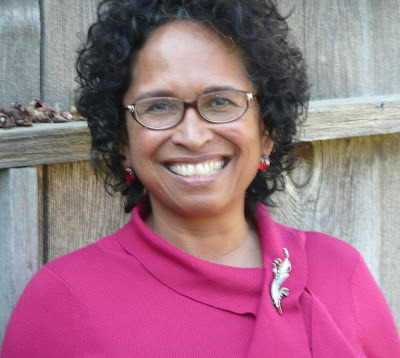
Diana, please tell us a bit about yourself.
“The biggest influences on me probably are being born to parents who worked in the fields and who were living in a labor camp when I was born. The camp and the people who lived and worked in the camp served as my earliest role models for what it is to live an honorable, hard-working life. At the end of your life, all you have is your reputation as a hard worker and the respect of those you worked with. Then, the San Joaquin Valley engraved its dry flatness on my consciousness. From an early age, I understood the importance of rain, the lack of rain when needed, the overabundance of rain at the wrong time. I reflect often on water and its many and various aspects. Finally, becoming a single mother when I was 20, struggling with the powerlessness of having to rely on welfare to make ends meet, filled me with a rage that's never completely left me. I discovered the tone deafness of those who have always known a privileged existence. It also makes me deeply grateful for all that I now have: a patient, generous husband and partner; parents, son and grandsons who make me proud to be part of the clan; and a university where I can teach what I've learned about writing and about living.”
Let me begin by asking about your work as a poet. You wrote the collection, When Living Was a Labor Camp, published in 2000. Such a moving title. Can you tell us about the impetus for that collection?
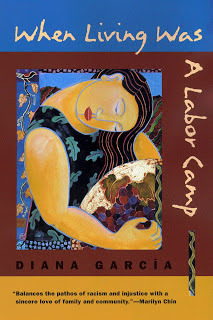 I wrote When Living Was a Labor Camp out of a deep commitment to the generations of farm workers whose sacrifices weren’t represented adequately in the poetry I read in the 1990s. In my own family, one uncle was poisoned and died after picking tomatoes in a field that had been sprayed with pesticides. Another uncle, a former bracero whose permit had expired, was picked up during Operation Wetback in the 50s and 60s and returned to Mexico. In both cases, the men left behind women who struggled to raise children on their own. I also wanted to capture the perseverance of the generations that followed, the children and grandchildren whose lives were impacted by prejudice. Finally, I wanted to write a book that my parents and my aunts and uncles could read, hear and understand and know their lives, and those of their children, were being honored.
I wrote When Living Was a Labor Camp out of a deep commitment to the generations of farm workers whose sacrifices weren’t represented adequately in the poetry I read in the 1990s. In my own family, one uncle was poisoned and died after picking tomatoes in a field that had been sprayed with pesticides. Another uncle, a former bracero whose permit had expired, was picked up during Operation Wetback in the 50s and 60s and returned to Mexico. In both cases, the men left behind women who struggled to raise children on their own. I also wanted to capture the perseverance of the generations that followed, the children and grandchildren whose lives were impacted by prejudice. Finally, I wanted to write a book that my parents and my aunts and uncles could read, hear and understand and know their lives, and those of their children, were being honored.
In what ways does creativity shape your work and your life?
I have always trusted my response to the natural world, that sense of self that is best reflected by moments in nature. Similarly, when I write, I feel a sense of connectedness to the world around me, to the expressions and experiences reverberating in the world. Writing also is like intellectual weight lifting for me. Much as a sturdy weight lifting workout leaves me drained and tranquil, a good bout of writing leaves my brain strangely emptied and refreshed.
I know you teach an upper division course, Social Action Writing. How did that course evolve and can you tell us a bit about it?
California State University Monterey Bay, established in 1994, is the first university in the CSU system to require 30 hours of service learning at each of the lower and upper division levels. Within our interdisciplinary humanities and communication major, two such courses, “Social Action Writing” and “Creative Writing and Service Learning” (originally titled “Creative Writing for Teachers”), were developed as part of our creative writing and social action program. The focus is on learning as much as it is on service. We value the commitment our neighboring communities—Seaside, Salinas, Marina, Monterey and Pacific Grove—made to converting the former Ft. Ord to a university. Not just communities, but the neighboring counties of San Benito and Santa Cruz were also involved. We want our students to learn from this level of civic engagement, this commitment to the issues affecting our neighbors and colleagues. In “Creative Writing and Service Learning,” students focus on using creative writing to engage children’s creativity and imagination in after school and community school programs. In “Social Action Writing,” depending on the theme that semester, students might work with community partners examining substandard housing, pesticide poisoning, educational inequality, or the peace movement. Our partnerships are on-going and a vital part of our students’ education.
In a political introduction recently, Obama was described as “burning on the inside” referring to his passion for a just nation. Though I was only with you briefly, my sense is that Diana Garcia also burns on the inside. Am I right?
Injustices of any kind anger me, especially since in most cases, injustice is leveled by those with power against those who are voiceless and powerless.
What were you like as a child and what advice would you have given to that young, beautiful self?
As a child, I was a bookworm, reclusive, and living in a world of my imagination. I imagined a world of books, of teaching, of travel. I never would have imagined that all my dreams would come true, and then some!

Diana, please tell us a bit about yourself.
“The biggest influences on me probably are being born to parents who worked in the fields and who were living in a labor camp when I was born. The camp and the people who lived and worked in the camp served as my earliest role models for what it is to live an honorable, hard-working life. At the end of your life, all you have is your reputation as a hard worker and the respect of those you worked with. Then, the San Joaquin Valley engraved its dry flatness on my consciousness. From an early age, I understood the importance of rain, the lack of rain when needed, the overabundance of rain at the wrong time. I reflect often on water and its many and various aspects. Finally, becoming a single mother when I was 20, struggling with the powerlessness of having to rely on welfare to make ends meet, filled me with a rage that's never completely left me. I discovered the tone deafness of those who have always known a privileged existence. It also makes me deeply grateful for all that I now have: a patient, generous husband and partner; parents, son and grandsons who make me proud to be part of the clan; and a university where I can teach what I've learned about writing and about living.”
Let me begin by asking about your work as a poet. You wrote the collection, When Living Was a Labor Camp, published in 2000. Such a moving title. Can you tell us about the impetus for that collection?
 I wrote When Living Was a Labor Camp out of a deep commitment to the generations of farm workers whose sacrifices weren’t represented adequately in the poetry I read in the 1990s. In my own family, one uncle was poisoned and died after picking tomatoes in a field that had been sprayed with pesticides. Another uncle, a former bracero whose permit had expired, was picked up during Operation Wetback in the 50s and 60s and returned to Mexico. In both cases, the men left behind women who struggled to raise children on their own. I also wanted to capture the perseverance of the generations that followed, the children and grandchildren whose lives were impacted by prejudice. Finally, I wanted to write a book that my parents and my aunts and uncles could read, hear and understand and know their lives, and those of their children, were being honored.
I wrote When Living Was a Labor Camp out of a deep commitment to the generations of farm workers whose sacrifices weren’t represented adequately in the poetry I read in the 1990s. In my own family, one uncle was poisoned and died after picking tomatoes in a field that had been sprayed with pesticides. Another uncle, a former bracero whose permit had expired, was picked up during Operation Wetback in the 50s and 60s and returned to Mexico. In both cases, the men left behind women who struggled to raise children on their own. I also wanted to capture the perseverance of the generations that followed, the children and grandchildren whose lives were impacted by prejudice. Finally, I wanted to write a book that my parents and my aunts and uncles could read, hear and understand and know their lives, and those of their children, were being honored. In what ways does creativity shape your work and your life?
I have always trusted my response to the natural world, that sense of self that is best reflected by moments in nature. Similarly, when I write, I feel a sense of connectedness to the world around me, to the expressions and experiences reverberating in the world. Writing also is like intellectual weight lifting for me. Much as a sturdy weight lifting workout leaves me drained and tranquil, a good bout of writing leaves my brain strangely emptied and refreshed.
I know you teach an upper division course, Social Action Writing. How did that course evolve and can you tell us a bit about it?
California State University Monterey Bay, established in 1994, is the first university in the CSU system to require 30 hours of service learning at each of the lower and upper division levels. Within our interdisciplinary humanities and communication major, two such courses, “Social Action Writing” and “Creative Writing and Service Learning” (originally titled “Creative Writing for Teachers”), were developed as part of our creative writing and social action program. The focus is on learning as much as it is on service. We value the commitment our neighboring communities—Seaside, Salinas, Marina, Monterey and Pacific Grove—made to converting the former Ft. Ord to a university. Not just communities, but the neighboring counties of San Benito and Santa Cruz were also involved. We want our students to learn from this level of civic engagement, this commitment to the issues affecting our neighbors and colleagues. In “Creative Writing and Service Learning,” students focus on using creative writing to engage children’s creativity and imagination in after school and community school programs. In “Social Action Writing,” depending on the theme that semester, students might work with community partners examining substandard housing, pesticide poisoning, educational inequality, or the peace movement. Our partnerships are on-going and a vital part of our students’ education.
In a political introduction recently, Obama was described as “burning on the inside” referring to his passion for a just nation. Though I was only with you briefly, my sense is that Diana Garcia also burns on the inside. Am I right?
Injustices of any kind anger me, especially since in most cases, injustice is leveled by those with power against those who are voiceless and powerless.
What were you like as a child and what advice would you have given to that young, beautiful self?
As a child, I was a bookworm, reclusive, and living in a world of my imagination. I imagined a world of books, of teaching, of travel. I never would have imagined that all my dreams would come true, and then some!
Published on September 30, 2012 04:47
September 25, 2012
Fall Beauty in the Desert
I’ve spent much of my life in the Chihuahua Desert of the Southwest. I’m at home in this landscape that some consider stark and bare. Yes, it gets plenty hot, but it also rains, though not often enough, and we do shiver in snow. The desert teaches me to notice: small wildflowers and the lizards I so cherish. In the fall, Santa Fe turns to gold: locust and immense cottonwood trees, sunflowers, firewheels (gaillardias), chamisa (rabbitbrush), yellow wildflowers such as golden crownbeard--all transform hills, fields, paths, gardens: suffuse them with light. I wish I could meet all of you who visit my blog. Here’s a small gift.
A Bouquet of Wild Asters
When nights cool,
wild asters wriggle
out of the desert sand, s t r e t c h
day after day, and gradually unfold
into surprises:
lavender bouquets.
Pat Mora ©
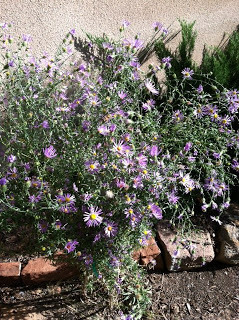
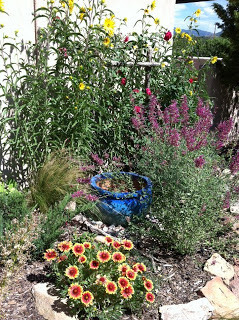

A Bouquet of Wild Asters
When nights cool,
wild asters wriggle
out of the desert sand, s t r e t c h
day after day, and gradually unfold
into surprises:
lavender bouquets.
Pat Mora ©


Published on September 25, 2012 04:00
September 19, 2012
What Does History Teach Us?
Some months back, while skimming a magazine on a treadmill, I read an article, “The Art of Gaman” and learned that gaman in Japanese refers to “bearing the seemingly unbearable with patience and dignity.” The article was about a traveling exhibit (that also became a book), and I noticed that the exhibit was coming here, to Santa Fe. I saw the exhibit, and though I had read a number of articles about it, the experience was heart-breaking.
Facts seldom cause us to fully feel sorrow. The facts, that FDR issued Executive Order 9066 on February 19, 1942, that people of Japanese descent were now officially labeled our enemies, don’t force us to ask: how did it feel to lose your rights, to be separated from your family, to live in “barracks” that were actually shacks, to be isolated, prisoners. How did families who were together strive to create a home in stark conditions? How did men in all-male camps such as one in Santa Fe draw on their emotional reserves and not only create a community, but in the various camps, create art. They taught themselves and one another to be inordinately resourceful making rings from peach pits, making beautiful wooden bird pins inspired by an article in National Geographic. The group in Santa Fe painted and wrote poetry.
And today, seventy years later, what have we learned about how we treat those who don’t look like us or who may speak another language or languages? Fear breeds hatred and heartache. How do we teach our young to learn from the past?
Watch the video "The Art of Gaman" by Smithsonian Magazine.
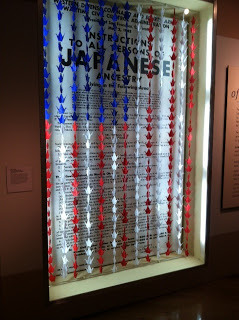
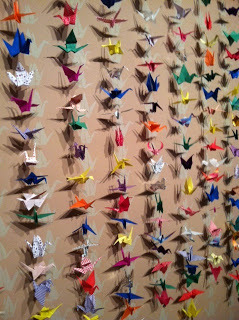
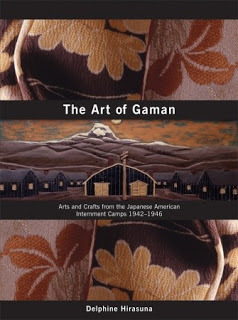 The Art of Gaman: Arts and Crafts from the
The Art of Gaman: Arts and Crafts from the
Japanese Internments Camps 1942-1946
by Delphine Hirasuna
Facts seldom cause us to fully feel sorrow. The facts, that FDR issued Executive Order 9066 on February 19, 1942, that people of Japanese descent were now officially labeled our enemies, don’t force us to ask: how did it feel to lose your rights, to be separated from your family, to live in “barracks” that were actually shacks, to be isolated, prisoners. How did families who were together strive to create a home in stark conditions? How did men in all-male camps such as one in Santa Fe draw on their emotional reserves and not only create a community, but in the various camps, create art. They taught themselves and one another to be inordinately resourceful making rings from peach pits, making beautiful wooden bird pins inspired by an article in National Geographic. The group in Santa Fe painted and wrote poetry.
And today, seventy years later, what have we learned about how we treat those who don’t look like us or who may speak another language or languages? Fear breeds hatred and heartache. How do we teach our young to learn from the past?
Watch the video "The Art of Gaman" by Smithsonian Magazine.


 The Art of Gaman: Arts and Crafts from the
The Art of Gaman: Arts and Crafts from the Japanese Internments Camps 1942-1946
by Delphine Hirasuna
Published on September 19, 2012 14:08
September 17, 2012
Bookjoy: Developing Día for Its 17th Anniversary
Next month we will learn the 2012 winner(s) of the Estela and Raúl Mora Award. They’ll join the list of 17 other impressive, exemplary programs since 2000. My personal theme for Día in the coming academic year is Developing Día. Zen Buddhists refer to Beginner’s Mind, the concept of trying to embark on a project with a fresh and curious mind. To all of you newbies or experienced Día planners: how can we work individually and collectively to deepen Día’s work between September and April 30th? Are we being as inclusive as we could be in building year-long partnerships with parents, schools, colleges, media, organizations, etc.? If we repeat our planning in a rote fashion, and limit that to an annual celebration, won’t we lose our initial excitement about Día’s potential? If we believe in Día’s importance as a daily commitment, día por día, day by day, how do we embrace and share progressive change?
April is the month of culminating Día book fiestas that celebrate family literacy and a year of linking all children to books, languages and cultures, but Día is not a one-day event.

An example of expanding Día comes from my friend Meryle Leonard at Charlotte Mecklenburg Library. Meryle and her team coined the idea of DÍA as Diversity in Action and now her collagues have instituted a Latino Task Force to increase services to the Latino families in their community. Yea to my NC friends! I'd appreciate receiving other examples of expanding Día locally or state-wide.

April is the month of culminating Día book fiestas that celebrate family literacy and a year of linking all children to books, languages and cultures, but Día is not a one-day event.

An example of expanding Día comes from my friend Meryle Leonard at Charlotte Mecklenburg Library. Meryle and her team coined the idea of DÍA as Diversity in Action and now her collagues have instituted a Latino Task Force to increase services to the Latino families in their community. Yea to my NC friends! I'd appreciate receiving other examples of expanding Día locally or state-wide.
Published on September 17, 2012 16:21
September 15, 2012
September E-newsletter
The September issue of the Pat Mora e-newsletter debuts a new format. Are you signed up to get it? If not, click on the sign-up image at the top left of this blog, or read the September issue online.

Image: 'Fall Fireworks' http://www.flickr.com/photos/47365658@N00/283079453
Found on flickrcc.net


Image: 'Fall Fireworks' http://www.flickr.com/photos/47365658@N00/283079453
Found on flickrcc.net
Published on September 15, 2012 07:50
September 11, 2012
Mora Award Judging

I'm grateful to the five dedicated REFORMA members who are currently busy reading the 2012 Estela and Raúl Mora Award applications. Each application conveys the commitment of librarians, educators and community members willing to invest their resources and talents in spreading bookjoy, alegría en los libros. It's exciting to report that this year, we have 16 applications from 9 states: AZ,CA, CO, FL, IL, NM, NY, TX, WA. We'll announce the winner in October. I applaud and am deeply grateful to each institution that hosted a Día celebration and that took the time to submit an application. I am also, of course, grateful to the judges.

Published on September 11, 2012 11:32
September 3, 2012
The Moon and a Poem
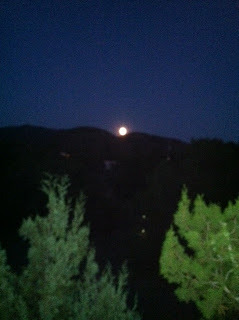 Love the moon? I do, especially on full-moon nights. I tend to feel a bit stunned by the beauty of that celestial radiance. Wanted to share this picture of the moon rising above the Santa Fe hills recently. Here's a companion poem from my book BORDERS(1986). Though hard, the moon seems such a benevolent body of light.
Love the moon? I do, especially on full-moon nights. I tend to feel a bit stunned by the beauty of that celestial radiance. Wanted to share this picture of the moon rising above the Santa Fe hills recently. Here's a companion poem from my book BORDERS(1986). Though hard, the moon seems such a benevolent body of light.Home
It only happened once
spinning in the desert white
with moonlight, glancing down,
rabbits, snakes, small burrowing owls
in a circle round her bare feet,
stretching too toward the moon,
snakes charmed by silent music.
Closing her eyes, feeling the pull
as they spun round
her knee, breasts, touching
her long hair, circling higher
in a funnel through which she rose
pushing upward, upward, grazing stars
with her fingertips and toes
her body light
finally curling on the moon
which circled round her
while she slept, slipped her
softly on the desert floor at dawn.
by Pat Mora ©
Published on September 03, 2012 10:56
August 30, 2012
Creativity Salon: an Interview With Poet Malena Mörling
Welcome to Bookjoy Creativity Salon, Malena! It's exciting to interview a Swedish poet now living where I do in Santa Fe, NM. I met you thanks to poet Janice Gould who was recently part of our salon. It has been such a pleasure to read fine poems in your first book Ocean Avenue. I look forward to savoring Astoria, your second book. Malena, please tell us a bit about yourself. What are you doing in New Mexico?
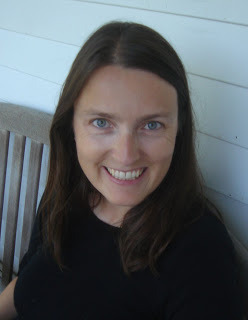 I live here--my family and I have lived here now for five years, which is the longest we have ever lived anywhere continuously. We came to Santa Fe in the fall of 2007 when I was invited to be a writer-in-residence at The School For Advanced Research for the school year. It became clear to us fairly soon after we arrived, that Santa Fe felt like a place where we could work, live and be. And leaving simply became impossible as the year went on. It was the first time in years that I for instance, felt perfectly at home. It is a wonderful thing to feel after years of feeling uprooted and being on the move.
I live here--my family and I have lived here now for five years, which is the longest we have ever lived anywhere continuously. We came to Santa Fe in the fall of 2007 when I was invited to be a writer-in-residence at The School For Advanced Research for the school year. It became clear to us fairly soon after we arrived, that Santa Fe felt like a place where we could work, live and be. And leaving simply became impossible as the year went on. It was the first time in years that I for instance, felt perfectly at home. It is a wonderful thing to feel after years of feeling uprooted and being on the move.
You are a poet, translator, professor and mom. I’m always interested in how a busy woman creates time for her creative writing. How do you do that?
I am not entirely sure how to do anything, nor how I do and have done things. Every day is a different experience, and so is the experience of writing as well. Every time I write a poem it occurs in a different way. Writing has become a seamless part of my life, of who I am. Sometimes I write while I am doing other things, thinking about other things. Because a poem often appears when I least expect it, it is like, while out walking, coming upon a street performer after turning a corner. Every time I write something it occurs in a different way, at a different time--I think that is, in a way, what I love about writing and living. The uncertainty and the unpredictability of just how or when a poem might present itself.
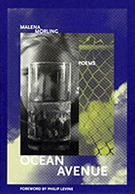
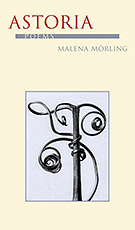
I don’t believe I’ve interviewed a translator before. How did that practice and talent evolve? What is a key challenge of translation for you?
I did not plan to begin translating. When I was an undergraduate, I was obsessed with a book of poems--it was 1933 by Philip Levine. I think he was the first living poet that I read. I must have read his book some 59 times or so and that 59th time I was reading it, I was traveling on an airplane, flying back to New York from Copenhagen and I began to hear the poems in my mind in Swedish. Maybe it was because I was still thinking in Swedish then, after having spent some weeks in Sweden. Anyway, I just wrote down the poems in Swedish next to the English originals in the book. They were quick first drafts--that I then revised for years. I just published my translation of that book in Sweden last summer. But that is how I began translating. I think one of the greatest challenges of translating is to make a poem as good or perhaps even better in the language you are translating it into, to honor, if not always the precise meaning of a poem, but maybe the urgency and or the arc of its lyrical voice. And if not that, then to attempt to bring across some other aspect of it like the formal structure, or maybe the distinct music of a poem.
And how does it feel to be a translator of Tomas Transtömer, winner of the 2011 Nobel Prize in Literature?
Oh, I was so beyond myself excited that Tomas received the Nobel Prize--he is such a profoundly resonant and influential poet. He is the most translated European poet--he has been translated into over 60 languages and has, what is unusual, a global literary presence. I also believe that I heard that he is the most translated poet into English--after Rumi, Rilke and Neruda. So I am just one of many who translate him, it is wonderful, wonderful work because I love it and I inevitably learn so much from it.
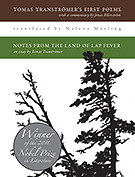
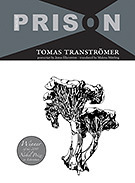
You’ve translated from Swedish to English and English to Swedish. Was one more difficult than the other? Since I have now lived in the US more than twice as long as I lived in Sweden and since I write mostly in English, it has become a little easier for me to translate from Swedish to English than the other way around.
I’m always curious to savor the first lines of a book, the entering into a space created of words. The first lines of Ocean Avenue are such a pleasurable reading experience:
In the shape of a human body
I am visiting the earth;
Is there another shape in which you’d like to visit the earth?
Maybe a tree. It appeals to me to be a tree--to be rooted in the earth. Is it not what we all in a way long for? To be more rooted, more grounded in our own experience? Also maybe a mountain, that would be cool or conversely a bird since I imagine that it would be incredible to fly.
Like all good poems, yours invite re-reading and sharing. I was keenly aware of how attentive you can be: of yourself, your surroundings, and of our physical impermanence, of death. Yet, there is a quiet hopefulness in your poems as in “Three Daffodils”:
but in the end we feed
the earth with ourselves.
Do you sense your hopefulness?
Yes, I do. I think that I am in a sense, pretty much hopelessly hopeful. I think that I somewhere along the way must have consciously decided to be hopeful--I feel that the human world is much too negative to have yet another person contributing to its negativity. I once had a vision that what we do here in this universe does not simply occur in the space of it--it helps create it--is a seamless part of it, as much as anything else is an equal and seamless part of it.
What is particularly challenging about teaching poetry?
Possibly that I don’t quite believe in the idea or the possibility of teaching anyone anything. That teaching is not about teaching but about something else. That it is more a matter of sharing poetry and somehow engaging the students in such a way that they themselves begin to ask themselves and the world the kind of questions that are pointed enough and evocative enough to provide them with inspiration to continue reading and writing.
Has being Swedish influenced your work even when you’re not writing about anything connected with Sweden?
I am sure it has since I believe that nothing is without effect, as Somerset Maugham wrote In the Razor’s Edge. I believe that what we write is inevitably and seamlessly connected to who are, what we have experienced and so on.
Were you always a reader and did you always enjoy reading poetry?
I grew up loving to read--but never poetry, I read fiction quite steadily. I never read poetry until after I left Sweden and I went to High School in the US and my English teacher decided one day to read aloud to us T.S. Eliot’s, “Love Song of J. Alfred Prufrok.” While he was reading the poem, I fell in love with poetry--I thought it was the most profoundly beautiful thing I had ever heard. I could not believe my ears, that experience changed me. That day I knew that I was going to spend my life writing poems in English, that that was what I was going to do with my life.
Visit Malena's website.
 I live here--my family and I have lived here now for five years, which is the longest we have ever lived anywhere continuously. We came to Santa Fe in the fall of 2007 when I was invited to be a writer-in-residence at The School For Advanced Research for the school year. It became clear to us fairly soon after we arrived, that Santa Fe felt like a place where we could work, live and be. And leaving simply became impossible as the year went on. It was the first time in years that I for instance, felt perfectly at home. It is a wonderful thing to feel after years of feeling uprooted and being on the move.
I live here--my family and I have lived here now for five years, which is the longest we have ever lived anywhere continuously. We came to Santa Fe in the fall of 2007 when I was invited to be a writer-in-residence at The School For Advanced Research for the school year. It became clear to us fairly soon after we arrived, that Santa Fe felt like a place where we could work, live and be. And leaving simply became impossible as the year went on. It was the first time in years that I for instance, felt perfectly at home. It is a wonderful thing to feel after years of feeling uprooted and being on the move. You are a poet, translator, professor and mom. I’m always interested in how a busy woman creates time for her creative writing. How do you do that?
I am not entirely sure how to do anything, nor how I do and have done things. Every day is a different experience, and so is the experience of writing as well. Every time I write a poem it occurs in a different way. Writing has become a seamless part of my life, of who I am. Sometimes I write while I am doing other things, thinking about other things. Because a poem often appears when I least expect it, it is like, while out walking, coming upon a street performer after turning a corner. Every time I write something it occurs in a different way, at a different time--I think that is, in a way, what I love about writing and living. The uncertainty and the unpredictability of just how or when a poem might present itself.


I don’t believe I’ve interviewed a translator before. How did that practice and talent evolve? What is a key challenge of translation for you?
I did not plan to begin translating. When I was an undergraduate, I was obsessed with a book of poems--it was 1933 by Philip Levine. I think he was the first living poet that I read. I must have read his book some 59 times or so and that 59th time I was reading it, I was traveling on an airplane, flying back to New York from Copenhagen and I began to hear the poems in my mind in Swedish. Maybe it was because I was still thinking in Swedish then, after having spent some weeks in Sweden. Anyway, I just wrote down the poems in Swedish next to the English originals in the book. They were quick first drafts--that I then revised for years. I just published my translation of that book in Sweden last summer. But that is how I began translating. I think one of the greatest challenges of translating is to make a poem as good or perhaps even better in the language you are translating it into, to honor, if not always the precise meaning of a poem, but maybe the urgency and or the arc of its lyrical voice. And if not that, then to attempt to bring across some other aspect of it like the formal structure, or maybe the distinct music of a poem.
And how does it feel to be a translator of Tomas Transtömer, winner of the 2011 Nobel Prize in Literature?
Oh, I was so beyond myself excited that Tomas received the Nobel Prize--he is such a profoundly resonant and influential poet. He is the most translated European poet--he has been translated into over 60 languages and has, what is unusual, a global literary presence. I also believe that I heard that he is the most translated poet into English--after Rumi, Rilke and Neruda. So I am just one of many who translate him, it is wonderful, wonderful work because I love it and I inevitably learn so much from it.


You’ve translated from Swedish to English and English to Swedish. Was one more difficult than the other? Since I have now lived in the US more than twice as long as I lived in Sweden and since I write mostly in English, it has become a little easier for me to translate from Swedish to English than the other way around.
I’m always curious to savor the first lines of a book, the entering into a space created of words. The first lines of Ocean Avenue are such a pleasurable reading experience:
In the shape of a human body
I am visiting the earth;
Is there another shape in which you’d like to visit the earth?
Maybe a tree. It appeals to me to be a tree--to be rooted in the earth. Is it not what we all in a way long for? To be more rooted, more grounded in our own experience? Also maybe a mountain, that would be cool or conversely a bird since I imagine that it would be incredible to fly.
Like all good poems, yours invite re-reading and sharing. I was keenly aware of how attentive you can be: of yourself, your surroundings, and of our physical impermanence, of death. Yet, there is a quiet hopefulness in your poems as in “Three Daffodils”:
but in the end we feed
the earth with ourselves.
Do you sense your hopefulness?
Yes, I do. I think that I am in a sense, pretty much hopelessly hopeful. I think that I somewhere along the way must have consciously decided to be hopeful--I feel that the human world is much too negative to have yet another person contributing to its negativity. I once had a vision that what we do here in this universe does not simply occur in the space of it--it helps create it--is a seamless part of it, as much as anything else is an equal and seamless part of it.
What is particularly challenging about teaching poetry?
Possibly that I don’t quite believe in the idea or the possibility of teaching anyone anything. That teaching is not about teaching but about something else. That it is more a matter of sharing poetry and somehow engaging the students in such a way that they themselves begin to ask themselves and the world the kind of questions that are pointed enough and evocative enough to provide them with inspiration to continue reading and writing.
Has being Swedish influenced your work even when you’re not writing about anything connected with Sweden?
I am sure it has since I believe that nothing is without effect, as Somerset Maugham wrote In the Razor’s Edge. I believe that what we write is inevitably and seamlessly connected to who are, what we have experienced and so on.
Were you always a reader and did you always enjoy reading poetry?
I grew up loving to read--but never poetry, I read fiction quite steadily. I never read poetry until after I left Sweden and I went to High School in the US and my English teacher decided one day to read aloud to us T.S. Eliot’s, “Love Song of J. Alfred Prufrok.” While he was reading the poem, I fell in love with poetry--I thought it was the most profoundly beautiful thing I had ever heard. I could not believe my ears, that experience changed me. That day I knew that I was going to spend my life writing poems in English, that that was what I was going to do with my life.
Visit Malena's website.
Published on August 30, 2012 17:20
Pat Mora's Blog
- Pat Mora's profile
- 96 followers
Pat Mora isn't a Goodreads Author
(yet),
but they
do have a blog,
so here are some recent posts imported from
their feed.



